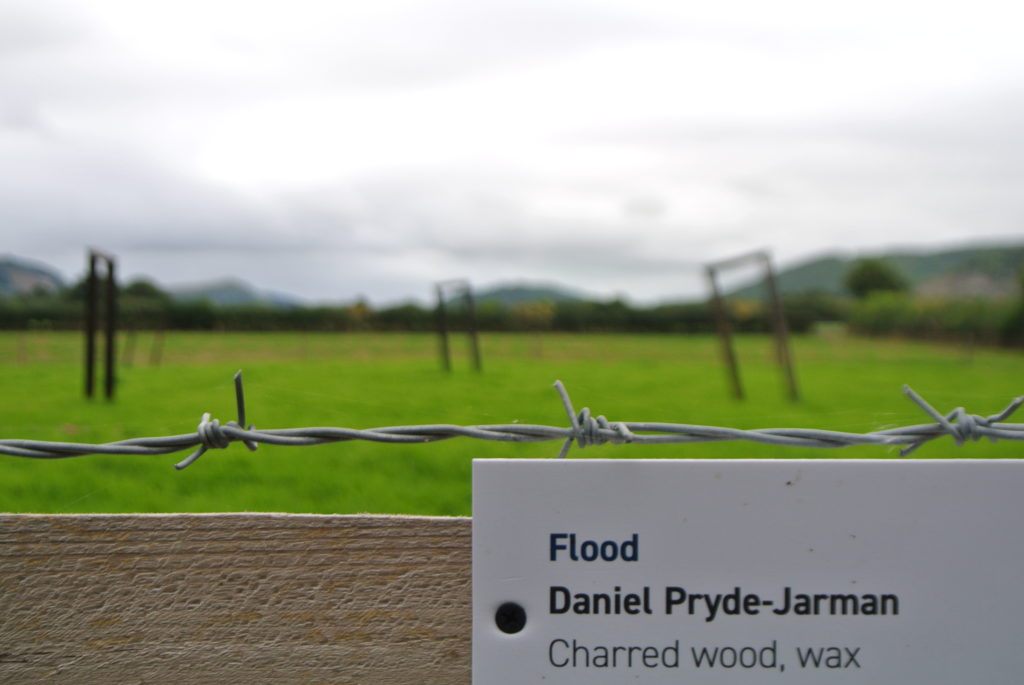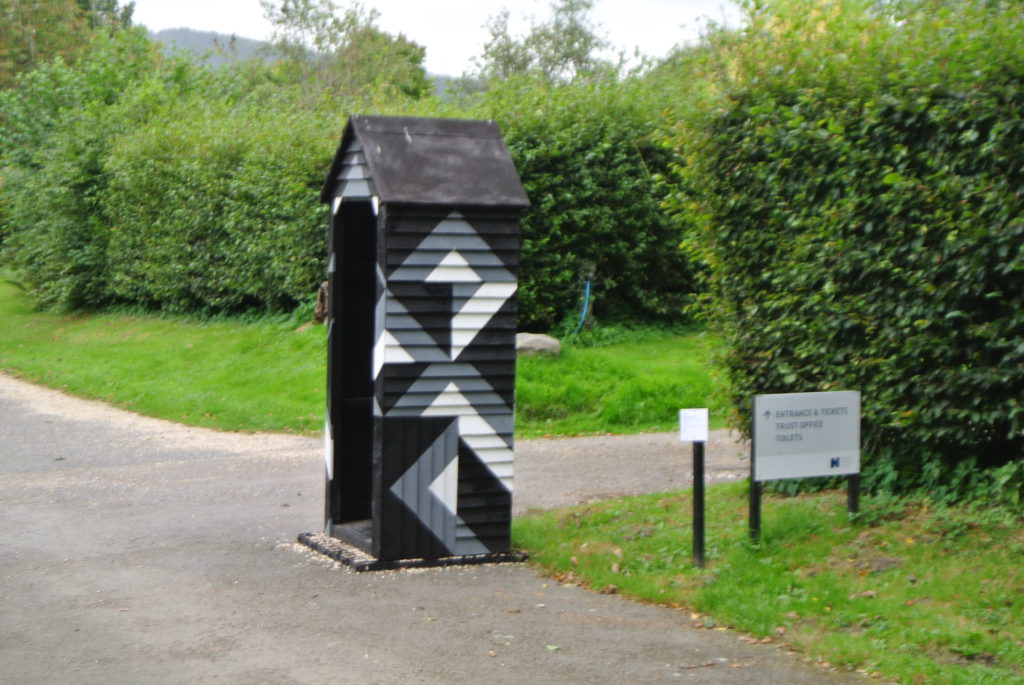
Sidney Nolan Trust is a bucolic arts centre, which nestles in a valley carved out by a glacier. Along with acres of green land, the late Australian artist’s Herefordshire estate comprises a calmly ramshackle residential home, a preserved studio overstocked with spray paint, and an outlying barn which has become a gallery to show, largely, Nolan’s work. At time of visit, the show was dedicated to prints made in response to Auschwitz.
Daniel Pryde-Jarman, whose exhibition intervenes economically in the surrounding grounds, has responded to lesser evils. But whereas the impossibility of representing the holocaust is a commonplace observation, Pryde-Jarman does make visible a number of otherwise hidden facets of imperialism: be that American, Soviet, pre-Soviet or post-British.
His sculptural show is characterised by a simplicity of form and a broadly shared aesthetic where stark angularity contrasts with the vernacular architecture, and where the organic finish tends to blend in. His key motif is a doorway and, if you include an opening framing his installation in the Granary, one counts almost a dozen doorways across his four works in the show. Eight of these are in a state of collapse; two lead nowhere. And to step through the empty frame in the Granary would be to find yourself in mid air.

Most of the doors are arranged in a small field by the Centre’s car park. Their charred wood frames, empty, lean left and right and invite the eye to navigate a grassy field enclosed with barbed wire, and they offer nowhere to rest. There is an aspect of horror to the emptiness of these doors: no interior; there is no shelter from the drizzling grey skies. Picking my way across the spongy grass, I break a cobweb to step through one of these portals and wonder what my participation means; because these frames are haunted by a dark, unlikely referent.
This work is called Flood and all seven of these openings are based on images found online which showed the aftermath of a flood at a settlement made to train soldiers at Fort Irwin in the Californian desert. These doors look like doors which look like the doors of a generic street of a town in the Middle East. Until the 2013 monsoon, US military could hone their lethal abilities storming terrorist living rooms and smoking out bedroom snipers. Here the remains of this sophisticated folly are abstracted with little or no comment. In our remote corner of the Welsh borders, where the beautiful villages seem ever tranquil, the reality of the so-called war on terror is made obliquely tangible here, as is the weirdness.

The Granary is a small, raised barn with swept flagstone floor and solid timber rafters. The space looks newly restored, but obsolete farm machinery, mounted on the wall, wears an orange patina of age. Equally antique are the three squat monoliths, prefabricated by the artist in his Hereford studio. Two of these taper, like obelisks; the other is stepped like the Cenotaph; and all three have a rough, aged concrete finish. But tap one with a knuckle and it returns a hollow knocking sound. They represent empty plinths and all three have the potential to return to that function. In this storage place for grain, they stand dormant.
As before, this piece has a parallel in the outside world, which Pryde-Jarman came upon, online. Google Streetview meant that he could base these plinths on proportions seen on originals in Eastern Europe, which have fallen into disuse, having been designed to support statues of Lenin. Pryde-Jarman was working with plinths prior to events in Bristol in June last year. We know now statues can be toppled, but plinths are hard to destroy. Here they offer a sense of both hope and danger that these will be restored or repurposed. The three forms, arranged at irregular angles, fill this barn with potential and tension.

Back outside, another vacant concrete monument rises more than three metres above the Sidney Nolan apple orchard. It is rendered to look solid with a finish as stony as that of the plinths. And, as a narrow, terraced house, it encases an open doorway, with an unglazed window on the floor above. But this structure is askew, like the ghostly doors of Fort Irwin. And since the window opens onto the sky, this structure fools no one. One can pass behind the standing stone to inspect the plywood frame and admire its workmanlike artifice.
That said, this piece puts us briefly in the slippers of Catherine the Great. She is said to have gazed from her carriage upon entire villages erected in this way, like theatre scenery, to give the false impression her subjects were living well. This elaborate subterfuge was the work of her closest advisor, friend and lover, Grigori Potemkin, who has since given his name to any device, from flashmob to state news broadcast, which portrays a happy and contented population for propaganda purposes. This piece too goes by the title Potemkin.

Two final doorways which open onto closed space are to be found in a pair of sentry boxes stationed at the entrances to the centre and to the car park. Whereas the previous works embody ideas, and have been finished by charring, rendering, or concrete, the paintwork on the final piece is the concept itself. The sentry box is put together like a garden shed with gable roof and slats. But it is painted with interlocking, dynamic black, white and grey shapes, which draw the attention and disturb the vision. The military don’t really go in for decoration (aside from medals), so this piece of loud, bright, albeit monochrome, security infrastructure is a wry oddity.
Dazzle camouflage, of which this is an example, was first used by ships in WWI, intended to confuse an opponent as to direction and speed. Its deployment here on a static sentry post, which no one is likely to shoot at, at a remote arts centre, rather than a working barracks is pleasantly baffling. One also wonders about the structure, why do sentries require boxes? With their benches, near redundant, inside, these two guardhouses are dwellings so small as to be pointless. This is toy-like architecture that lampoons its occupant.

This keen sense of the ridiculous reverberates strongly: from the vainglory of 18th century Russia through to the 21st century war games of the most powerful army on earth. In a world gone proverbially mad, these extreme follies – Arab villages in the Mojave desert; temporary towns in the Crimea; the wholesale decommissioning of plinths; self-conscious sentries – well belong. But their appearance here at Sidney Nolan, where the pace is slow and the setting idyllic, makes visible a threat to all.
It brings to mind of Poussin’s classically classical painting, Et in Arcadia Ego. So reads a stone inscription, on a tomb, found by some shepherds: ‘death is in Arcadia too’. Pryde-Jarman delivers a similar warning, but with a light touch in keeping with our absurd times.
Daniel Pryde-Jarman was exhibiting at Sidney Nolan Trust, Presteigne, Herefordshire: May-September 2021.